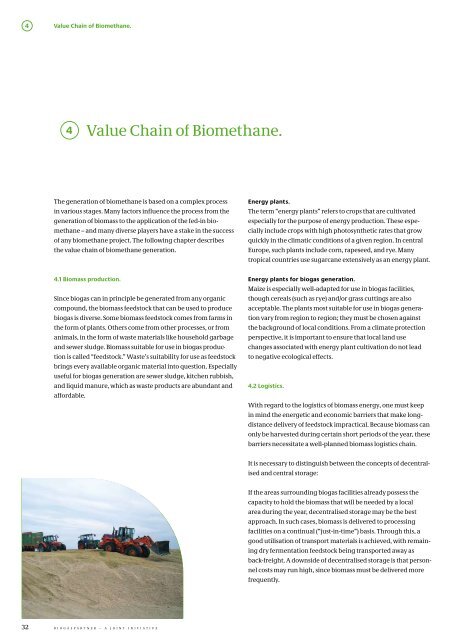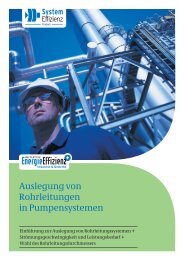biogaspartner – a joint initiative.
biogaspartner – a joint initiative.
biogaspartner – a joint initiative.
Create successful ePaper yourself
Turn your PDF publications into a flip-book with our unique Google optimized e-Paper software.
Value.Chain.of.Biomethane.<br />
value Chain of Biomethane.<br />
The generation of biomethane is based on a complex process<br />
in various stages. Many factors influence the process from the<br />
generation of biomass to the application of the fed-in biomethane<br />
<strong>–</strong> and many diverse players have a stake in the success<br />
of any biomethane project. The following chapter describes<br />
the value chain of biomethane generation.<br />
4.1.Biomass.production..<br />
since biogas can in principle be generated from any organic<br />
compound, the biomass feedstock that can be used to produce<br />
biogas is diverse. some biomass feedstock comes from farms in<br />
the form of plants. others come from other processes, or from<br />
animals, in the form of waste materials like household garbage<br />
and sewer sludge. Biomass suitable for use in biogas production<br />
is called “feedstock.” Waste’s suitability for use as feedstock<br />
brings every available organic material into question. Especially<br />
useful for biogas generation are sewer sludge, kitchen rubbish,<br />
and liquid manure, which as waste products are abundant and<br />
affordable.<br />
32 B I o G a s P a r T n E r <strong>–</strong> a j o I n T I n I T I a T I v E<br />
Energy.plants..<br />
The term “energy plants” refers to crops that are cultivated<br />
especially for the purpose of energy production. These especially<br />
include crops with high photosynthetic rates that grow<br />
quickly in the climatic conditions of a given region. In central<br />
Europe, such plants include corn, rapeseed, and rye. Many<br />
tropical countries use sugarcane extensively as an energy plant.<br />
Energy.plants.for.biogas.generation..<br />
Maize is especially well-adapted for use in biogas facilities,<br />
though cereals (such as rye) and/or grass cuttings are also<br />
acceptable. The plants most suitable for use in biogas generation<br />
vary from region to region; they must be chosen against<br />
the background of local conditions. From a climate protection<br />
perspective, it is important to ensure that local land use<br />
changes associated with energy plant cultivation do not lead<br />
to negative ecological effects.<br />
4.2.Logistics.<br />
With regard to the logistics of biomass energy, one must keep<br />
in mind the energetic and economic barriers that make longdistance<br />
delivery of feedstock impractical. Because biomass can<br />
only be harvested during certain short periods of the year, these<br />
barriers necessitate a well-planned biomass logistics chain.<br />
It is necessary to distinguish between the concepts of decentral-<br />
ised and central storage:<br />
If the areas surrounding biogas facilities already possess the<br />
capacity to hold the biomass that will be needed by a local<br />
area during the year, decentralised storage may be the best<br />
approach. In such cases, biomass is delivered to processing<br />
facilities on a continual (“just-in-time”) basis. Through this, a<br />
good utilisation of transport materials is achieved, with remaining<br />
dry fermentation feedstock being transported away as<br />
back-freight. a downside of decentralised storage is that personnel<br />
costs may run high, since biomass must be delivered more<br />
frequently.









